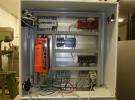I have been working on with some thermocouples and sampling 6 channels at 1 Hz. I have noticed some kind of problem with my CJC. I am using the LM34CAZ which has helped me get a more accurate reading from the thermocouples, however I am noticing on channel is jumping frequently. I attached a plot of my thermocouples and for some reason there is a channel that doesn't use the CJC correctly and reads higher than it should be. There is also one channel that is jumping.
So, I went looking for this error myself in Kipling and found that the channel that jumps is having CJC problems, eventhough it is set up the same as every other channel. The CJC Temperature jumps frequently from about 24 celsius to about 26.5 celsius. This is the only channel that has this reading of the CJC channel that is using a LM34CAZ. I tried changing the settling time and sampling all the way daown to 1/5 Hz but nothing seemed to help this issue.
Attached below is a plot for my thermocouples and the Kipling view of the jumping cold junction.
Thanks,
Thomas
EDIT: I tried connecting the CB37 to the T7-Pro and now there is no discrepancies. The thermocouples are reading the same relative temperatures so I'm guessing we bought a faulty cable from you guys.


.png%3Fitok=PHGBxf6M)


.jpg%3Fitok=B1YcuDFK)
.png%3Fitok=Ybt-OlgU)
What are you using for software? Can you replicate this same problem in LJLogM?
Add a channel recording the voltage from AIN12 so we can watch that.
Do you still see the problem if you just read AIN6_EF_READ_A by itself? Just that 1 channel. Or how about just 3 channels: AIN6_EF_READ_A, AIN6_EF_READ_B, and AIN12.
I think it has to do with how I am connecting the CB37 using the connector. I can't seem to get a good connection even with the extender screws for the M end. That is how the ground is connected I am guessing and when I just put the CB37 with no cable, it worked properly.
So if you just read AIN12 by itself can you see or cause any problems? 1.5 C the LM34 is something like 30 mV, so a very substantial voltage change.
In Kipling, I just read the AIN12 voltage and it was reporting 0.760 V. The room temperature where I am is measured with a remote sensor and is about 23.7 C.
This morning I was running some more tests and I read both channel 0 and 8 cold junction temperatures, and they give me the same reading. I attached a plot from the sampling and you can see that three thermocouples are reading around 23.2 C, which is about the room temperature, two thermocouples are reading about 25.6 C, and one thermocouple channel is jumping between those temperatures. Ch6 is a type-K thermocouple as well, just for validation that it is not due to a type-T issue.
Thomas
Can you simplify the test? The idea is to find the minimum system that demonstrates the issue, as that makes it easier to isolate the issue.
So perhaps remove all your thermocouples except 2. Keep 1 that is reading low and 1 that is reading high. Then run LJLogM with 5 channels:
AINx_EF_READ_A
AINx_EF_READ_B
AINy_EF_READ_A
AINy_EF_READ_B
AIN12
If you do see the problem in this data, try adding a 6th channel. Jumper VS to some AIN and log that AIN to confirm you are staying safely above 4.75 volts.
I removed all but two thermocouples and when I looked in LJLogM, the values reported seemed good. I also did the VS Jumper to check that and it looked good as well. I then kept adding thermocouples all the way down from the AIN12 terminal, so the last was AIN0 thermocouple. Everything looked good until I added the last thermocouple. It is reporting about 2.5 C higher. I check the VS to AIN0 and it seemed to be good, then I went into Kipling and it is that CJC voltage that is reading different from the others. (They all have the same value resistors connected.)
I replaced that thermocouple with another to make sure that I could consistantly see the error and it didn't fix anything. Attached are the values seen in LJLogM for all thermocouples and AIN12.
*Here is the picture*
Sorry, read-c is what I wanted not read-b. I want to see the CJ temperatures. So if you remove everything except AIN0 does it still have the problem?
AIN0_EF_READ_A
AIN0_EF_READ_C
AIN12
Does read-c not agree with AIN12 (10 mV/F)?
... or do you have to connect a 2nd thermocouple and then read like this?
AIN0_EF_READ_A
AIN0_EF_READ_B
AIN2_EF_READ_A
AIN2_EF_READ_B
AIN12
What if you leave LJLogM configured with the same 13 channels, but only the thermocouple on AIN0 is connected (and the LM34 on AIN12).
What if you use a different channel for the LM34?
If you could cause a problem with just 1 thermocouple on AIN0 and the LM34 on AIN2, you could then see if it makes a difference whether you use the CB37 or connect right on the T7. Or maybe with 2-3 single-ended thermocouples and the LM34.
Ok so after a while of testing these different things I have got some results.
If I remove everything except AIN0, it is still reading that high temperature. As well as the cold junction reading for that channel of the LM34. CJC_AIN0_Error.PNG shows that for you. However, if you look at the picture, CJC_AIN0_Kip.PNG, when I configure the channel settings in Kipling, the CJC voltage seen corresponds to a lower voltage, closer to room temperature and the channels match inside Kipling. Once I go into LJLogM, the voltage seems to increase and start to throw off the AIN0 reading again, like in the first picture.
I then tested having every channel the same and having only AIN0 thrermocouple reading, but this did not change any results for me in LJLogM, as seen in CJC_AIN0_Only.PNG. I also changed the channel to AIN2 for the LM34, this did not change anything either.
Next, I tried having the CB37 terminal board plug straight into the T7-Pro, and this seemed to alleviate the issues with CJC readings that were showing before, seen in CJC_AIN0_T7.PNG. The only concern that I have with this is that I plan on have the Mux80 and a few more terminal boards so I can have an entire test setiup to be ran in Python.
Lastly, I tried to do some Single-Ended measurements to see if that helped but the temrperature readings were too high. Upwards of 27.5 C for most of them which is not close to the room temperature. That is shown in CJC_SE.PNG.
Thanks,
Thomas
Note that when I am describing these tests I am trying to be specific about wiring and software setup. I might be specifying what is physically connected, and I might be describing what channels you are reading, and the 2 might not agree at all.
Something weird is going on, and it is obvious to see. Most of these things I am having you try are not solutions, but rather just tests to try to isolate the problem so we can then tackle it.
CJC_AIN0_Error.PNG:
80.7 F is 27.1 C, so your AIN12 reading in row #2 seems to agree with the read-c reading from row #1. If you add another AIN12 reading in row #5 what does it read?
It appears that you still have a thermocouple connected to AIN2 here, or does it just happen to be reading a reasonable value as a floating channel?
Yes, you should certainly be able to do that, but for now we are just trying different things to isolate your problem.
If you do this same setup (same 3 channels in LJLogM, 1 t/c connected to AIN0/1 with a resistor from AIN1 to GND, LM34 connected to AIN2) but connect to the CB37 instead of directly to T7, do you get different results? I don't see a screenshot like that.
That is because the T7 terminals are warmer than than the CB37. Don't worry about that. We are just focusing on whether everything reads the same, which it does in this screenshot. No problem in this SE screenshot. So if you do this identical thing on the CB37, all the t/c readings will drop a few degrees, but ignoring that does everything read the same and thus no problem?
I suggest you do all testing single-ended from here forward. It takes 1 complication off our plate.
How about this. Can you cause the problem with just the LM34 connected. Nothing else? If you need to read some ain-ef channels to cause the problem, just jumper those channels to GND. That would be something we can identically here.
Rather than tests, here is a jump to a possible problem identification and solution.
You are using a raw LM34CAZ sensor, right? Not some sort of probe? I wonder if certain combinations of things you do cause it to go slightly unstable? Try adding a 10k resistor from Vout to GND, which means AIN12 to GND. This means you will have 2 leads in AIN12, so as always pull on both to make sure both are clamped.
I apologize, I misunderstood you. When I was doing all of these measurements, they were all connected to the CB37, no sensors were connected to any terminals on the T7 board itself. When you mentioned connecting to the T7, I had connected the CB37 to the T7-Pro without using the cable that came with the terminal board that I have been using. I have not done anything with thermocouples connected at the T7-Pro channels, only the CB37 channels.
I see. So a DB37 cable between T7 and CB37 seems to allow the problem. That agrees with post #14, so try the 10k resistor for sure.